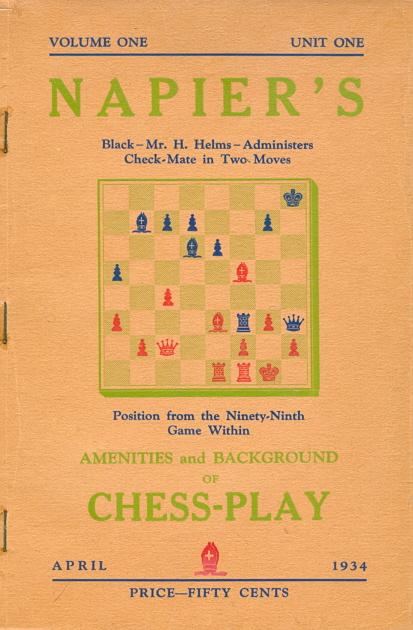
Edward Winter

The diagrammed position on the cover of W.E. Napier’s book comes from a famous miniature won by Hermann Helms, and Napier wrote: ‘Besides brilliancy, there is a debonair flow from the first move.’ Giving the score on pages 192-193 of The Golden Treasury of Chess (Philadelphia, 1943) Francis J. Wellmuth observed: ‘A most extraordinary game in that the final moves were wholly unexpected.’
1 d4 f5 2 Nf3 Nf6 3 c4 e6 4 Nc3 b6 5 e3 Bb7 6 Bd3 Bd6 7 a3 a5 8 O-O O-O 9 Qc2 Nc6 10 e4 fxe4 11 Nxe4 Nxe4 12 Bxe4
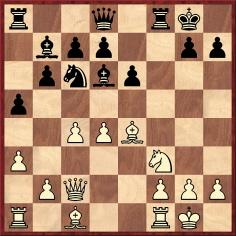
12...Nxd4 13 Bxh7+ Kh8 14 Nxd4 Qh4 15 g3 Qxd4 16 Bd3 Rf3 17 Be3 Qe5 18 Rae1 Raf8 19 Bxb6 Qh5 20 Be3 Qh3 21 Be4
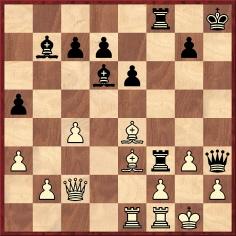
21...R8f5 22 Bxf5
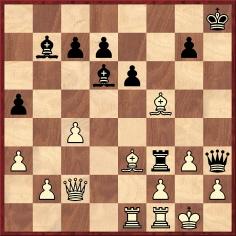
22...Qg2+ 23 Kxg2 Rxg3 mate.
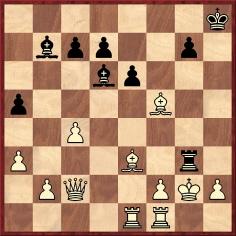
There are many discrepancies in the details surrounding the game. Pages 213-214 of the (truly dreadful) book Treasure Chess by B. Pandolfini (New York, 2007) stated that the opponent of ‘Herman Helms’ (Hermann is the correct spelling) was ‘Samuel Smyth’. Some sources give the surname as ‘Smith’. See, for instance, pages 183-184 of the Schachjahrbuch für 1915/16 by L. Bachmann (Ansbach, 1917), which had ‘J. Ferguson Smith’. Similarly, when the game was published on page 138 of Schnell Matt! by C. Hüther and L. Bachmann (Leipzig, 1924) White was named as ‘J.F. Smith’. On the other hand, ‘J.F. Smythe’ was the version offered when the game was included on page 185 of the July-August 1919 issue of the American Chess Bulletin (editor: H. Helms). However, that was an item reproduced from the New York Evening Post, with the moves merely incorporated within an annotation to another game.
An early appearance of the Helms miniature in a chess book was on pages 97-98 of Chess by David A. Mitchell (Philadelphia, 1917). He stated that White was J.F. Smyth, and a specific date for the game was given: 23 May 1915. Working backwards, we have found the score (probably its first publication) on page 3 of the Brooklyn Daily Eagle, 10 June 1915. Helms’ chess column in that newspaper identified White as J. Ferguson Smyth and stated that the miniature was a practice game played at the Manhattan Chess Club on 28 May 1915:

Nearly three decades later the game re-appeared in the American Chess Bulletin. A.E. Santasiere annotated Smyth v Helms on page 12 of the January-February 1943 issue, and his penultimate note read:
‘I wish our friend, the perpetrator of this deed, would relate to us the immediate reactions to this move [22...Qg2+] i.e. how did his opponent take it, the audience, etc., etc.’
Immediately afterwards, Helms elucidated:
‘The encounter was between James F. Smyth and H. Helms at the Manhattan Chess Club, then in the Carnegie Hall Building, early in this century. It was played as a practice game at the invitation of the former, who was to take part in the annual match with Philadelphia. Smyth, a transplanted Englishman, took his defeat like a good sportsman. A certified public accountant, his travels took him to the Pacific Coast, where he died in San Francisco.’
The match referred to was held in Philadelphia on 30 May 1915. Unfortunately, no player named J.F. Smyth was listed in the report on page 131 of the July-August 1915 American Chess Bulletin, although one member of the Manhattan Chess Club’s team was ‘M. Smith’.
This photograph comes from page 152 of the July-August 1917 American Chess Bulletin:

Hermann Helms
On page 50 of the February 1963 Chess Life John W. Collins wrote that in 1950 Santasiere produced an oil painting of the position preceding 22...Qg2+, and page 34 of the February 1963 Chess Review reported that the painting ‘hangs in the Marshall Chess Club’. Santasiere’s obituary on page 160 of the March 1977 Chess Life & Review related that ‘he had painted over 400 canvases’, but what details can be found about a painting depicting the Helms game?
A photograph from page 110 of the April 1943 Chess Review:
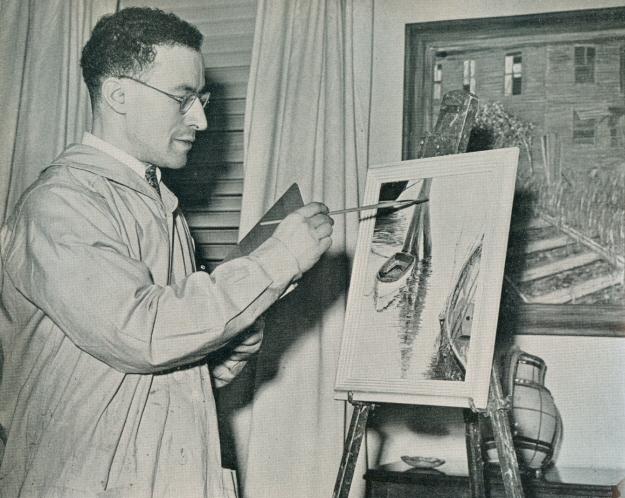
Anthony Edward Santasiere
As regards the 23-move brilliancy, the evidence currently available suggests the following:
James Ferguson Smyth v Hermann Helms
Practice game, Manhattan Chess Club, New York, 28 May 1915.
The above article originally appeared at ChessBase.com.
From a ‘Chess Movies’ article on the inside front cover of the January 1959 Chess Review:
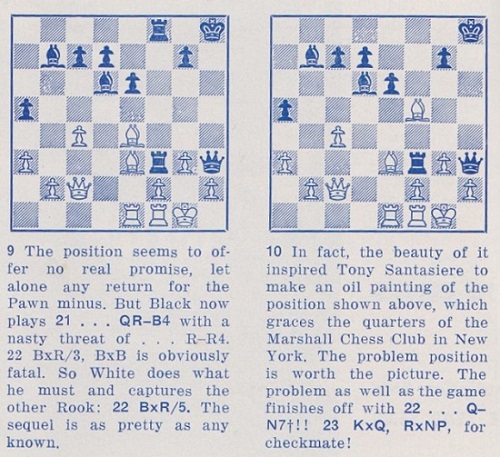
Concerning the painting by A.E. Santasiere depicting the game in question, Ronald Young (Bronx, NY, USA) reports that he saw the picture hanging in the Marshall Chess Club in 2003 and noted that the position reproduced was not precise. He asks whether a photograph can be obtained.
We are grateful to Frank Brady (New York, NY, USA) for taking the following photograph of the painting, which is still in the Marshall Chess Club’s possession:
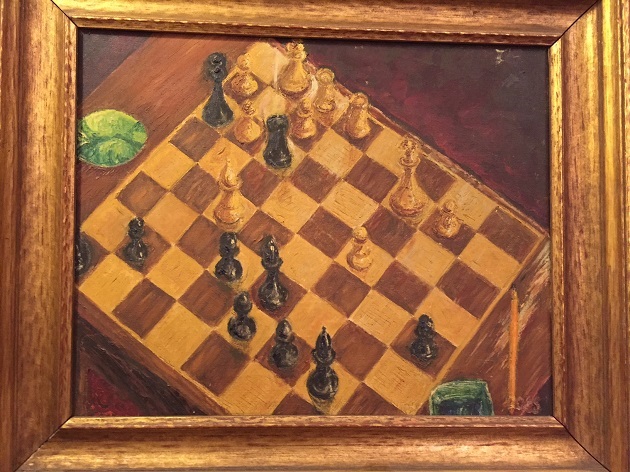

Black to move
Although well known, Hermann Helms’ brilliancy against Smyth, played in New York in 1915, sometimes appears as Schmidt v Helms, Germany, 1925. See, for instance, page 220 of A Complete Chess Course by Antonio Gude (London, 2015), as well as page 83 of Checkmate Tactics by Garry Kasparov (London, 2010):
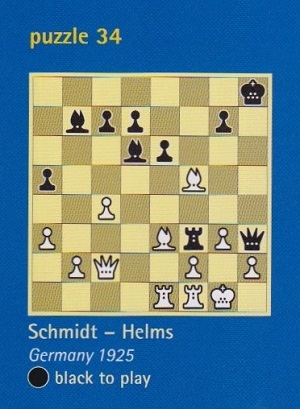
(9627)
When Irving Chernev gave the Smyth v Helms game on pages 488-489 of 1000 Best Short Games of Chess (New York, 1955), his final note quoted Helms:
‘Now comes an unusual finish, which was as pleasing to the loser as it was to the winner.’
Where did Helms make that remark?
(9632)
Pages 101-102 of Chess Tactics by Alexander Kotov (London, 1983) gave the conclusion of the game with the diagram caption ‘Composed position.’
Further to the description of Hermann Helms on page 8 of the New York Post, 14 February 1942 as the ‘dean of the American chess press’ (C.N. 10786), we mention, firstly, a fine, extensive tribute to him (‘the undisputed Dean of American Chess’) by Frank Brady on pages 3-4 of Profile of a Prodigy (various editions). As shown below, however, the word ‘undisputed’ may be disputed.
Helms received the title officially at a testimonial dinner on 20 August 1943. From page 278 of the October 1943 Chess Review:
‘In recognition of his remarkable record and long devotion to the cause of chess, President Sturgis of the USCF conferred on Hermann Helms the official title of Dean of American Chess.’
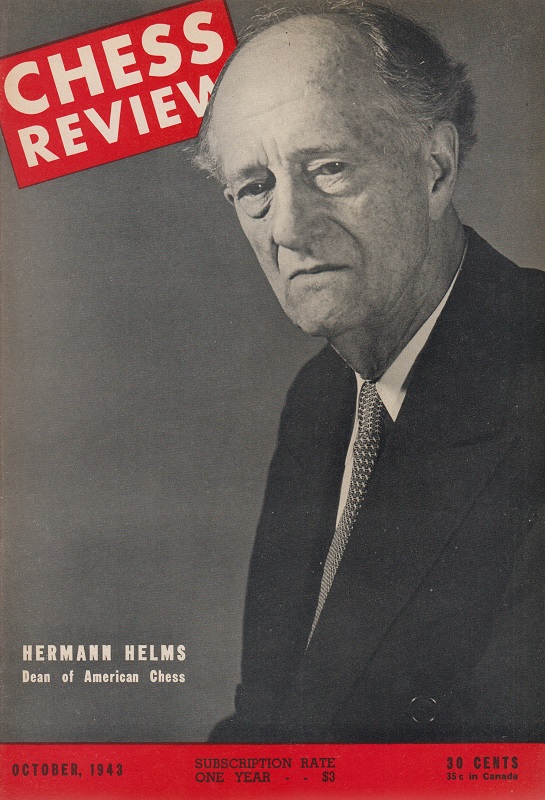
In the previous decade, versions of the title accorded to Helms were more limited, such as ‘the dean of American chess writers and publishers’ (Morning Call, 29 January 1933, page 10). The Cincinnati Enquirer of 12 November 1933 (page 2, section IV) wrote concerning Helms, ‘we believe he is the dean of American chess editors in experience, service and possibly age’.
Before the ‘official title of Dean of American Chess’ was conferred on Helms, similar titles had been given to others. Page 11 (Sports section) of the 25 August 1922 New York Times called Jackson Whipps Showalter the ‘dean of American chess players’. After publishing a letter from Walter Penn Shipley about Albert Beauregard Hodges, page 169 of the October 1941 Chess Review had an editorial note which began: ‘Rival candidate to the title of Dean of American Chess, octogenarian Shipley is a few years [sic] older than Hodges ...’ On page 168 of Capablanca’s Best Chess Endings (Oxford, 1978) Irving Chernev called Shipley ‘The Dean of American Chess for several generations’.
Page 67 of the March 1943 Chess Review referred to Frank James Marshall as the ‘Dean of American Chess’. Marshall, incidentally, was a speaker at the dinner at which the title was bestowed upon Helms (American Chess Bulletin, September-October 1943, page 73).
Showalter died in 1935, Shipley in 1942, and Hodges and Marshall in 1944. Following Marshall’s death, the 11 November 1944 edition of the Los Angeles Times (page 4, part I) called him the ‘dean of American chess masters’, and page 32 of the Brooklyn Daily Eagle, 12 November 1944 had the ‘dean of American chess players’:
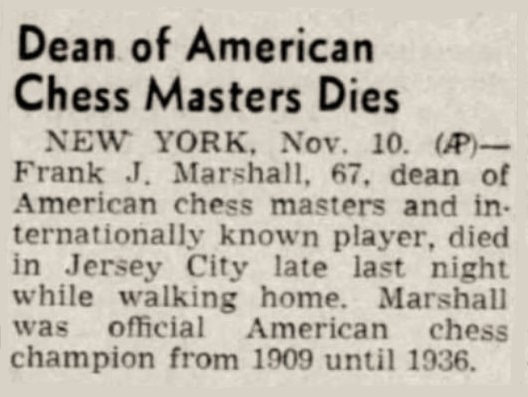
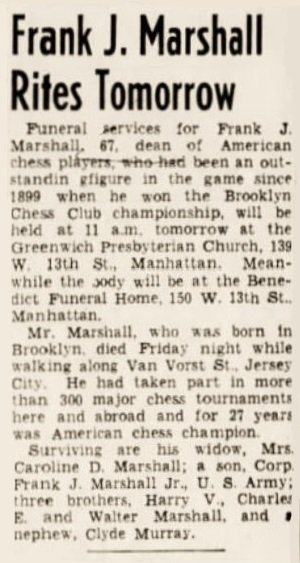
Reuben Fine was incorrect when he wrote on page 190 of The World’s Great Chess Games (New York, 1976) that Marshall ‘remained the dean of American chess until his death in 1943’.
On page 5 of the January 1946 Chess Review Fine applied the term ‘the dean of American chess masters’ to Edward Lasker. A brief tournament report on page 4 of the August 1947 Chess Review called Lasker ‘Dean of American Masters’ and Helms ‘Dean of American Chess’.
‘Dean of American Chessmasters’ was the description of Abraham Kupchik on the front cover of the May 1949 Chess Review:
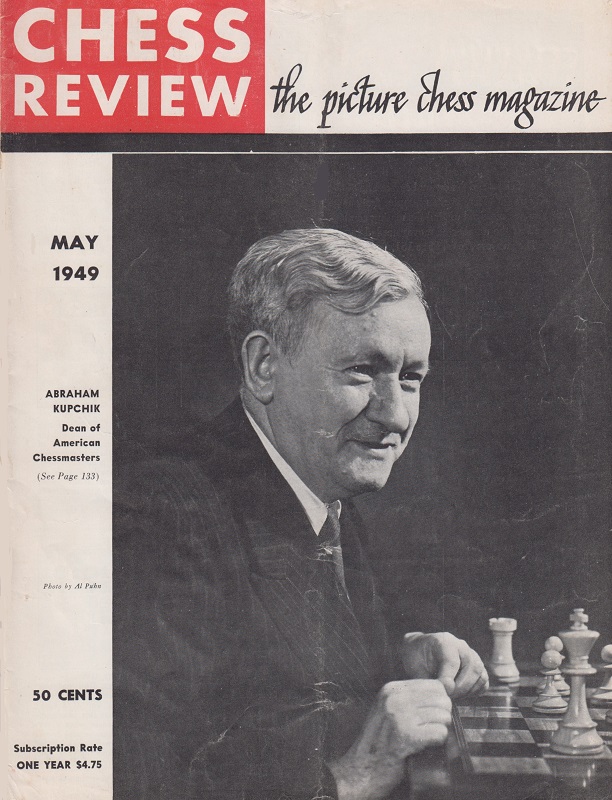
The corresponding article on page 133 stated: ‘Oldest and most durable of the masters competing in this series [Metropolitan Chess League matches] is Abraham Kupchik, dean of American chessmasters.’
How much significance or value the ‘dean’ title ever had is another question. As regards the perks, if that word is not too strong, on page 33 of the February 1963 Chess Life John W. Collins referred to Helms as ‘the Dean, an Honorary Member of all clubs in the United States’.
On page 31 of the same issue William Lombardy suggested that Helms, the ‘Dean of American Chess’, was ‘the Chess world’s most loved figure’:
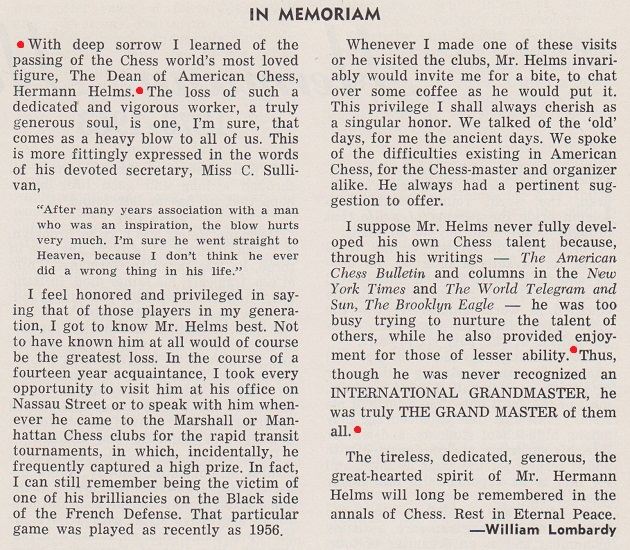
The brief notice of Helms’ death on page 72 of the March 1963 BCM had no geographical restrictions: he was ‘the doyen of all chess journalists’.
(10788)
To the Chess Notes main page.
To the Archives for other feature articles.
Copyright: Edward Winter. All rights reserved.